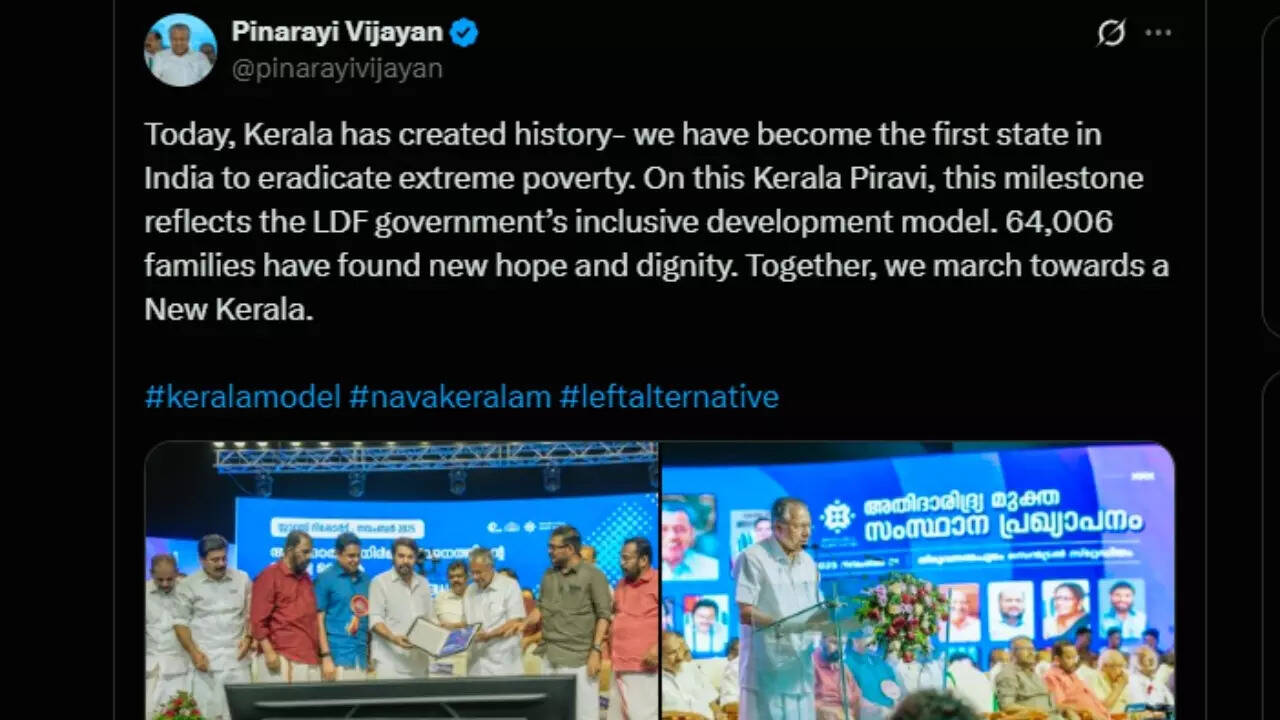ARTICLE AD BOX

Kerala has officially declared itself free from extreme poverty. The declaration, made by Chief Minister Pinarayi Vijayan during a special session of the Kerala Legislative Assembly on November 1, 2025, has made Kerala the first state in India to achieve this feat.
The announcement comes at the culmination of a four-year mission under the Extreme Poverty Eradication Project (EPEP), a state-led initiative launched in 2021 to uplift those left behind by previous welfare programmes. Chief Minister Vijayan, on his official handle on X, shared, “Today, Kerala has created history- we have become the first state in India to eradicate extreme poverty. On this Kerala Piravi, this milestone reflects the LDF government’s inclusive development model.
64,006 families have found new hope and dignity. Together, we march towards a New Kerala.”

CM Pinarayi Vijayan (@pinarayivijayan/X)
A four-year mission to leave no one behind
Kerala’s fight against extreme poverty began soon after the Left Democratic Front (LDF) government assumed office in 2021. In its first Cabinet meeting, the government decided to identify and rehabilitate families living in dire conditions, those without steady income, housing, food security, or access to healthcare.Within two months, local bodies across the state began mapping vulnerable families with the help of Kudumbashree volunteers, community workers, and local representatives.
Data collected at the ward level underwent multiple levels of verification, first by local committees and then by gram sabhas, ensuring transparency and accuracy.At the end of the survey, 1,03,099 individuals from 64,006 families were identified as living in extreme poverty.
What extreme poverty means, and how Kerala tackled it
According to the World Bank, extreme poverty is defined as living on less than USD 3 per day. Globally, around 830 million people are estimated to be in this category in 2025.
Kerala’s initiative didn't limit itself to income. It also included access to essentials like food, housing, education, and healthcare as critical indicators.Under the EPEP, over 21,000 individuals received essential documents like ration cards and Aadhaar cards to access government schemes. Food security was ensured for 20,648 families through Kudumbashree networks. Health interventions included providing access to medicines, vaccinations, palliative care, and even organ transplants.The housing mission LIFE provided homes for 4,677 families, while 2,713 families received both land and houses. Livelihood support reached 4,394 families, and over 35,000 families were included in the Mahatma Gandhi National Rural Employment Guarantee Scheme (MGNREGS). Education initiatives offered scholarships to 331 students and special support for 5,583 children, including free travel for schooling.Kerala’s declaration comes against the backdrop of national progress in poverty reduction.
Kerala, also home to the richest temple in India
Padmanabhaswamy Temple in Thiruvananthapuram is also the richest temple in India. Located in the heart of Kerala’s capital, the Sree Padmanabhaswamy Temple is dedicated to Lord Vishnu, depicted reclining on the serpent Anantha. While the temple has long been one of the most revered Vaishnavite shrines, its staggering wealth came to global attention in 2011, when a Supreme Court–ordered inventory of its underground vaults uncovered treasures of unimaginable scale.The temple’s secret chambers, especially the legendary Vault B, were found to contain gold coins, jewels, antique idols, golden thrones, and diamond-studded ornaments, collectively valued at over INR 1 lakh crore (approximately USD 18 billion). This revelation made Padmanabhaswamy not only the richest temple in India but also one of the wealthiest religious institutions in the world.Despite its vast wealth, the temple continues to function primarily as a place of worship. The Travancore royal family, who are the long-time custodians of the shrine, oversee its management under the supervision of the Supreme Court of India.

 4 hours ago
4
4 hours ago
4









 English (US) ·
English (US) ·